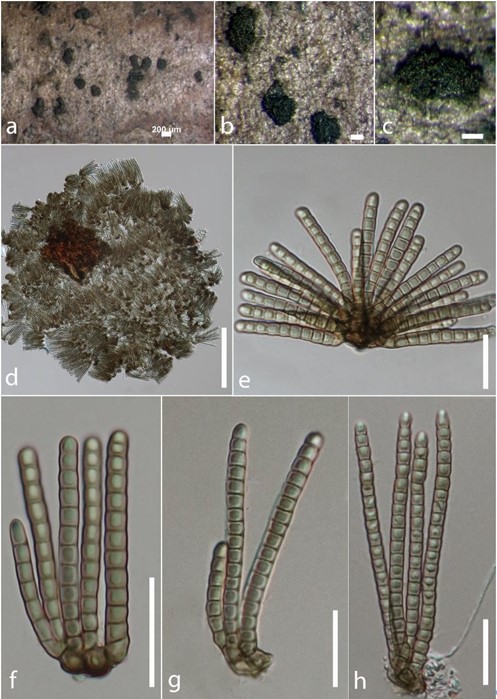Cryptocoryneum sp.
Saprobic on dead and unfallen twigs of Corylus avellana L. Sexual morph: Undetermined. Asexual morph: Sporodochia pulvinate, 259–385 × 50–100 µm (x̅ = 307.3 µm × 70.3 µm, n = 10) μm, often confluent, dark brown to black. Conidiophores arising from stromatic cells, straight, septate, pale brown to hyaline. Conidiogenous cells 4.2–6.9 × 4.7–7 µm (x̅ = 5.4 µm × 5.5 µm, n = 13) monoblastic, cylindrical to oblong, determinate, terminal, pale brown to hyaline. Conidia solitary, acrogenous, cheiroid, pale brown, cap cells firmly united together, 3–12 cylindrical arms, branched at the base, basal cells cuneiform, cylindrical, smooth, dark brown, 10–20-septate, slightly constricted at the septa, guttulate in each cell, 57–81 × 3.5–4.5 µm (x̅ = 74.5 × 3.8 µm, n = 25).
Material examined – Italy, lives on a dead and unfallen branch of Corylus avellana (Betulaceae), 21 January 2019, Erio Camporesi, IT2737 (MFLU 19-0442).
Notes – Cryptocoryneum is an asexual genus characterized by stromatic sporodochia, monoblastic conidiogenous cells, cheiroid conidia and conidial arms developing downward from the cap cells. However, we were unable to obtain sequence data from this specimen. Therefore, only morphology is provided here (Fig. 65).

Figure 65 – Cryptocoryneum sp. (MFLU 19-0442). a–c Sporodochium on a dead and land branch of Corylus avellana d Sporodochium. e–h Development of conidia. Scale bars: a = 200 μm, b–d = 100 μm, e–g, h = 20 μm, f = 10 μm.
